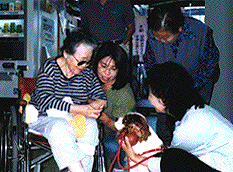|
Science & Technology || Sports & Fashion || Search || Back Numbers
HEALING TOUCH: Patients Stroke Away Anxiety with Animal Therapy June 16, 1998  An elderly lady reaches out to pet a canine visitor, while a co-resident looks on. (Goto Animal Hospital) Animal therapy, a medical technique in which patients gain physical and emotional relief by spending time with pets, seems to be gaining acceptance in more and more hospitals, nursing homes, and welfare institutions. The therapy takes a variety of forms: Emotionally disturbed children benefit from contact with dogs, and those suffering racing blood pressure or pulse rates get their vital signs back down by stroking rabbits, for instance. Animals can also help alleviate stress in everyday life, by providing people with a feeling of being surrounded by the warmth of a family. Pets are now no longer just pets, but are evolving into partners that can help bring calm to troubled human spirits. A Helping Paw Once a month, the garden of the Kyosai Tachikawa Hospital in downtown Tokyo fills up with dogs, cats, rabbits, hamsters, and other animals brought in by pet owners, veterinarians, and volunteers majoring in veterinary studies. Holding the dogs and cats to their chests, the vets go up to patients and use the animals to broach conversations. Invited to touch, one usually stoney-faced patient suffering from an emotional disorder slowly stretches out his hand and strokes the proffered dog's head. A cat clambers onto a patient's lap, causing a neighbor to smile. In 1994, Kyosai Tachikawa became the first hospital in Japan to introduce animal therapy. Explains a doctor who uses this method: "Just stroking an animal can make a patient feel relaxed, so that anxiety goes away and blood pressure is lowered. And an animal can provide a topic for conversation with or among patients. That makes relationships easier to build." Also making use of animals is the Japan Animal Hospital Association. Over the last 11 years, its staff have made over 1,100 visits to over 100 nursing homes and other institutions. Often old men with reputations for awkwardness get tearful when a dog is brought in. Although movement may be difficult, some embrace it and say things like "I'm so glad you came." Such visits are meticulously organized: To avoid the risk of infectious disease, the pet is always washed and checked for good health the day before, mealtimes are avoided, and visits are not allowed to go on too long. There are other ways in which the use of animals in therapeutic treatment is spreading. Autistic children can get in closer touch with the world around them by playing with dolphins; and children with cerebral palsy hone their sense of balance by riding horses.
An international information center for human-animal relations was established in the United States 20 years ago. It defined "animal-assisted therapy" as the process of deciding which animal should be used in the treatment of a given individual and at which stage. In Japan, the number of nursing homes and institutions for the disabled accepting visits by animal therapists has risen, but the number of hospitals and medical clinics doing so is still small and medical recognition has barely begun to spread. While hoping that the method will win broad acceptance, a doctor at Kyosai Tachikawa Hospital says that for animal-assisted therapy as practiced overseas to really take off in Japan, it will be necessary for a wide range of hospitals to embrace it.
 Edited by Japan
Echo Inc. based on domestic Japanese news sources. Articles
presented here are offered for reference purposes and do not
necessarily represent the policy or views of the Japanese
Government. Edited by Japan
Echo Inc. based on domestic Japanese news sources. Articles
presented here are offered for reference purposes and do not
necessarily represent the policy or views of the Japanese
Government.
|
